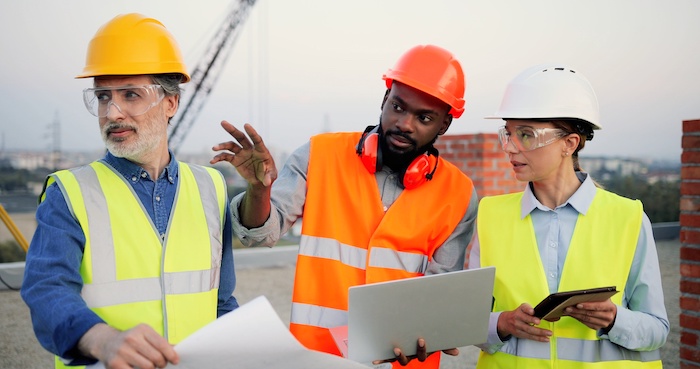 Jobsite safety is now a top priority across many companies. It really doesn’t take rocket science to understand its importance. If a workplace is unsafe, then accidents are going to be frequent. This can disrupt the smooth workflow, productivity, and efficiency of your team. Most importantly, businesses can fall into trouble with the law when they aren’t able to comply with jobsite safety requirements.
Jobsite safety is now a top priority across many companies. It really doesn’t take rocket science to understand its importance. If a workplace is unsafe, then accidents are going to be frequent. This can disrupt the smooth workflow, productivity, and efficiency of your team. Most importantly, businesses can fall into trouble with the law when they aren’t able to comply with jobsite safety requirements.
Workplace safety, also known as occupational health and safety, refers to the act of providing a safe working environment for everyone in the workplace. This encompasses the procedures, policies, and safety equipment and tools that have to be observed to mitigate the risk of many workplace accidents.
That said, here are five ways to ensure safety on the jobsite:
1) Consider Your Safety As Your Personal Responsibility
It’s not just enough to have the appropriate safety rules in the workplace if everyone is still negligent about this. While it’s the responsibility of your employer to provide a safe workplace that complies with all the safety hazard requirements, you should consider your safety as your personal responsibility.
Put it in your hands and not anyone else’s. This means that once you set foot in your workplace, you have to be on your guard and alert so as not to meet an accident at work. For example, you know that using your mobile phone is a big distraction as a machine operator or a heavy equipment driver. But, you let down your guard and use it to browse social media. Now, you meet an accident and injure your hand. That’s on you.
Most importantly, even if it’s not provided by your employer, this doesn’t mean that you shouldn’t invest in certain things that can keep you protected while on the jobsite. For instance, hard hats will almost always be provided. But, if you work in the construction industry, this means that you need to have good tradesman boots and working boots to keep you protected.
2) Identify Your Individual Workplace Hazards
Each workplace has their inherent safety risks. Understandably, these would be unique to the kind of jobsite you have. For example, you’re in the construction industry. A residential construction jobsite will have different risks, compared with those of a commercial building. So, putting aside the legal safety requirements that need to be complied with, you’ll also have to consider those risks that are unique to your site.
Identify the main source of these risks before your start building your workplace safety plan. Otherwise, there could be mismatch when the safety practices you employ don’t even address the specific needs of your jobsite.
3) Create A Workplace Safety Culture
Now that there are proper standards in place, you’ll also have to do a regular audit to ensure that this workplace safety culture is communicated across the jobsite. This means that every single employee is on the same page with the practices and expectations to comply with safety standards.
It’s not enough to just have these workplace safety hazard rules in place, but not discuss them. Perhaps, these topics only get touched on when an accident already happens. Discuss them periodically, or at least every time that you meet everyone in the jobsite as a team.
When you do so, it becomes company culture to prioritize safety while on the jobsite.
4) Never Take Shortcuts
Regardless of the jobsite that you’re running, surely, there are procedures for everything that needs to be done in the day. Whatever your position is, be sure that you abide by the proper steps and always follow the correct procedures. In essence, this means not taking any shortcuts.
The danger with shortcuts is that you may be compromising safety in exchange for achieving more and doing more within a day to speed up operations. Don’t make this mistake as this is when accidents may happen. Most importantly, the quality may also be affected when the proper procedures are no longer followed.
5) Create A Safety Communication Plan
Apart from workplace safety procedures that your jobsite will have, it also helps also to create a safety communication plan. In fact, this should form a big part of the core values of your jobsite and company in total.
Generally, this safety communication will contain jobsite updates, internal campaigns, and tools and materials to enable you to communicate all these to your employees at the right time.
That said, your safety communication plan should be able to address the following questions:
- What’s the main safety message that you want to get across for any given period?
- How will you measure whether or not these safety hazard plans are well communicated or not?
- What are the safety updates, per period, that have to be relayed to the team?
You can’t just have workplace safety tips and procedures in place without a proper safety communication plan. In other words, your jobsite safety strategies will only be successful when you’re able to manage to communicate these properly across your team.
Conclusion
Workplace accidents and injuries can stall the smooth flow of construction or jobsite operations. These can also lead to costly expenses for companies. Rather than be negligent about them, companies, in fact, have the responsibility to ensure the safety of everyone on the site. The tips above may only be simple ways, but they’re effective in creating a strategy that’ll work well for everyone on the job. Most importantly, when employees feel like they’re safe on the jobsite, this enables them to do more, be more productive, and, most importantly, feel happier in the workplace they’re in.
